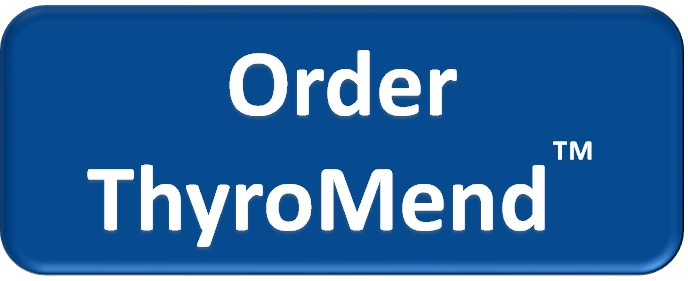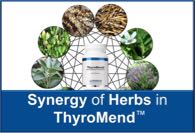
ThyroMend™ supports healthy metabolism by boosting the production of thyroid hormones and the conversion of T4 into the more active T3 thyroid hormone. The herbs improve thyroid hormone function and prevent thyroid hormone resistance.
A synergistic combination of iodine containing seaweeds, and herbs which contain phytothyroidogenic, phyto-thyroid-receptor agonists, and other herbs designed to promote optimal function of thyroid hormones by maintaining the health of thyroid hormone producing tissues and by supporting the healthy function of tissues that respond to thyroid hormones.This unique combination of seaweeds and herbs synergistically supports the SEVEN KEY FUNCTIONS associated with OPTIMAL THYROID HEALTH, due to its ability to support:
increased bio-available iodine for thyrocytes
increased iodine uptake by thyrocytes through interactions with sodium-iodide-symporter (NIS) proteins
increased T3 & T4 production and secretion from thyrocytes
increased conversion of thyroxine (T4) to the more bioactive triiodothyronine (T3) by liver cells;
increased RXR/TR heterodimerization of thyroid receptors on target cells throughout the body
increased binding of thyroid hormone receptors to DNA by RXR/TR heterodimers throughout the body
increased affect of T3 on target gene expression within receptor cells throughout the body
How is ThyroMend™ used?
ThyroMend™ is used by healthcare professionals to increase naturally production of thyroid hormones by the thyroid gland, increase conversion of T4 to the more active T3 hormone, and increase the ability of cells to respond to thyroid hormones. ThyroMend™ improves patients with many conditions including:
Patients who do not need thyroid replacement therapy, but still have low thyroid symptoms. Symptoms may be present with “normal” hormone levels if the levels are below the 30th percentile of the reference range. This “subclinical hypothyroidism” can be improved with ThyroMend™ which can increase thyroid hormone production and thyroid hormone function.
Patients who are on thyroid medication but still have symptoms. When symptoms persist even when thyroid replacement results in “normal” lab values it can be due to thyroid hormone resistance (poor thyroid receptor function). ThyroMend™ improves thyroid receptor function and eliminates symptoms of thyroid hormone resistance.
Patients who want to wean off of thyroid replacement therapy. Using ThyroMend™ a month before weaning off of thyroid replacement can make weaning successful in patients if their thyroid has not been removed, or destroyed by autoimmune disease.
References:
Iodine: Caldwell KL, Jones R, Hollowell JG. Urinary iodine concentration: United States National Health And Nutrition Examination Survey 2001-2002. Thyroid. 2005 Jul;15(7):692-9.
Borak J. Adequacy of iodine nutrition in the United States. Conn Med. 2005 Feb;69(2):73-7.
Gaitan JE, Mayoral LG, Gaitan E. Defective thyroidal iodine concentration in protein-calorie malnutrition. J Clin Endocrinol Metab. 1983 Aug;57(2):327-33.
Bladderwrack (Fucus vesiculosus): Campbell WR. Diet and nutrition: iodine in normal nutrition. Can Med Assoc J. 1939 Jan; 40(1): 77-79.
Butler MR. Comparison of the chemical composition of some marine algae. Plant Physiol. 1931 Apr; 6(2): 295-305.
Skibola CF. The effect of Fucus vesiculosus, an edible brown seaweed, upon menstrual cycle length and hormonal status in three pre-menopausal women: a case report. BMC Complement Altern Med. 2004 Aug 4;4:10.
Skibola CF, Curry JD, VandeVoort C, Conley A, Smith MT. Brown kelp modulates endocrine hormones in female sprague-dawley rats and in human luteinized granulosa cells. J Nutr. 2005 Feb;135(2):296-300.
Norwegian Seaweed (Ascophyllum nodosum): Butler MR. Comparison of the chemical composition of some marine algae. Plant Physiol. 1931 Apr; 6(2): 295-305.
Howie AF, Walker SW, Akesson B, Arthur JR, Beckett GJ. Thyroidal extracellular glutathione peroxidase: a potential regulator of thyroid-hormone synthesis. Biochem J. 1995 Jun 15;308 ( Pt 3):713-7.
Saker KE, Fike JH, Veit H, Ward DL. Brown seaweed- (Tasco) treated conserved forage enhances antioxidant status and immune function in heat-stressed wether lambs. J Anim Physiol Anim Nutr (Berl). 2004 Apr;88(3-4):122-30.
Guggulsterones (Commiphora mukul): Panda S, Kar A. Gugulu (Commiphora mukul) induces triiodothyronine production: possible involvement of lipid peroxidation. Life Sci. 1999;65(12):PL137-41.
Panda S, Kar A. Guggulu (Commiphora mukul) potentially ameliorates hypothyroidism in female mice. Phytother Res. 2005 Jan;19(1):78-80.
Brobst DE, Ding X, Creech KL, Goodwin B, Kelley B, Staudinger JL. Guggulsterone activates multiple nuclear receptors and induces CYP3A gene expression through the pregnane X receptor. J Pharmacol Exp Ther. 2004 Aug;310(2):528-35. Epub 2004 Apr 1.
Lee S, Privalsky ML. Heterodimers of retinoic acid receptors and thyroid hormone receptors display unique combinatorial regulatory properties. Mol Endocrinol. 2005 Apr;19(4):863-78. Epub 2005 Jan 13.
Wang X, Greilberger J, Ledinski G, Kager G, Paigen B, Jurgens G. The hypolipidemic natural product Commiphora mukul and its component guggulsterone inhibit oxidative modification of LDL. Atherosclerosis. 2004 Feb;172(2):239-46.
Rosemary (Rosmarinus officinalis): Steiner M, Priel I, Giat J, Levy J, Sharoni Y, Danilenko M. Carnosic acid inhibits proliferation and augments differentiation of human leukemic cells induced by 1,25-dihydroxyvitamin D3 and retinoic acid. Nutr Cancer. 2001;41(1-2):135-44.
Danilenko M, Wang X, Studzinski GP. Carnosic acid and promotion of monocytic differentiation of HL60-G cells initiated by other agents. J Natl Cancer Inst. 2001 Aug 15;93(16):1224-33.
Li D, Li T, Wang F, Tian H, Samuels HH.Functional evidence for retinoid X receptor (RXR) as a nonsilent partner in the thyroid hormone receptor/RXR heterodimer. Mol Cell Biol. 2002 Aug;22(16):5782-92.
Lee S, Privalsky ML. Heterodimers of retinoic acid receptors and thyroid hormone receptors display unique combinatorial regulatory properties. Mol Endocrinol. 2005 Apr;19(4):863-78.
Petersen M, Simmonds MS. Rosmarinic acid. Phytochemistry. 2003 Jan;62(2):121-5. Review.
Pereira P, Tysca D, Oliveira P, da Silva Brum LF, Picada JN, Ardenghi P. Neurobehavioral and genotoxic aspects of rosmarinic acid. Pharmacol Res. 2005 Sep;52(3):199-203
Huang SC, Ho CT, Lin-Shiau SY, Lin JK. Carnosol inhibits the invasion of B16/F10 mouse melanoma cells by suppressing metalloproteinase-9 through down-regulating nuclear factor-kappa B and c-Jun. Biochem Pharmacol. 2005 Jan 15;69(2):221-32. Epub 2004 Nov 23.
Lo AH, Liang YC, Lin-Shiau SY, Ho CT, Lin JK. Carnosol, an antioxidant in rosemary, suppresses inducible nitric oxide synthase through down-regulating nuclear factor-kappaB in mouse macrophages. Carcinogenesis. 2002 Jun;23(6):983-91.
Sage (Salvia officinalis): Rutherford DM, Nielsen MP, Hansen SK, Witt MR, Bergendorff O, Sterner O. Isolation and identification from Salvia officinalis of two diterpenes which inhibit t-butylbicyclophosphoro[35S]thionate binding to chloride channel of rat cerebrocortical membranes in vitro. Neurosci Lett. 1992 Feb 3;135(2):224-6.
Munne-Bosch S, Alegre L. Drought-induced changes in the redox state of alpha-tocopherol, ascorbate, and the diterpene carnosic acid in chloroplasts of Labiatae species differing in carnosic acid contents. Plant Physiol. 2003 Apr;131(4):1816-25.
Schwarz K, Ternes W. Antioxidative constituents of Rosmarinus officinalis and Salvia officinalis. II. Isolation of carnosic acid and formation of other phenolic diterpenes. Z Lebensm Unters Forsch. 1992 Aug;195(2):99-103.
Perry EK, Pickering AT, Wang WW, Houghton P, Perry NS. Medicinal plants and Alzheimer's disease: Integrating ethnobotanical and contemporary scientific evidence. J Altern Complement Med. 1998 Winter;4(4):419-28.
Eidi M, Eidi A, Bahar M.Effects of Salvia officinalis L. (sage) leaves on memory retention and its interaction with the cholinergic system in rats. Nutrition. 2006 Mar;22(3):321-6.
Tildesley NT, Kennedy DO, Perry EK, Ballard CG, Wesnes KA, Scholey AB. Positive modulation of mood and cognitive performance following administration of acute doses of Salvia lavandulaefolia essential oil to healthy young volunteers. Physiol Behav. 2005 Jan 17;83(5):699-709.
Kennedy DO, Pace S, Haskell C, Okello EJ, Milne A, Scholey AB. Effects of Cholinesterase Inhibiting Sage (Salvia officinalis) on Mood, Anxiety and Performance on a Psychological Stressor Battery. Neuropsychopharmacology. 2005 Oct 5
Ashwagandha (Withania somnifera): Panda S, Kar A. Changes in thyroid hormone concentrations after administration of ashwagandha root extract to adult male mice. J Pharm Pharmacol. 1998 Sep;50(9):1065-8.
Panda S, Kar A. Withania somnifera and Bauhinia purpurea in the regulation of circulating thyroid hormone concentrations in female mice. J Ethnopharmacol. 1999 Nov 1;67(2):233-9.
van der Hooft CS, Hoekstra A, Winter A, de Smet PA, Stricker BH. [Thyrotoxicosis following the use of ashwagandha] Ned Tijdschr Geneeskd. 2005 Nov 19;149(47):2637-8. Dutch.
Ahmad M, Saleem S, Ahmad AS, Ansari MA, Yousuf S, Hoda MN, Islam F. Neuroprotective effects of Withania somnifera on 6-hydroxydopamine induced Parkinsonism in rats. Hum Exp Toxicol. 2005 Mar;24(3):137-47.
Jain S, Shukla SD, Sharma K, Bhatnagar M. Neuroprotective effects of Withania somnifera Dunn. in hippocampal sub-regions of female albino rat. Phytother Res. 2001 Sep;15(6):544-8.
Coleus (Coleus forskohlii): Laurberg P. Forskolin stimulation of thyroid secretion of T4 and T3. FEBS Lett. 1984 May 21;170(2):273-6.
Hiraiwa M. Adenylate cyclase system responsive to thyroid stimulating hormone (TSH) of porcine thyroid cells in primary monolayer cultures. Potential effect of forskolin on TSH-mediated adenylate cyclase stimulation. Nippon Naibunpi Gakkai Zasshi. 1987 Jan 20;63(1):34-44.
van Sande J, Cochaux P, Dumont JE. Forskolin stimulates adenylate cyclase and iodine metabolism in thyroid. FEBS Lett. 1982 Dec 13;150(1):137-41.
Venkateswaran A, Marsee DK, Green SH, Jhiang SM. Forskolin, 8-Br-3',5'-cyclic adenosine 5'-monophosphate, and catalytic protein kinase A expression in the nucleus increase radioiodide uptake and sodium/iodide symporter protein levels in RET/PTC1-expressing cells. J Clin Endocrinol Metab. 2004 Dec;89(12):6168-72.
Brahmi (Bacopa monniera): Kar A, Panda S, Bharti S. Relative efficacy of three medicinal plant extracts in the alteration of thyroid hormone concentrations in male mice. J Ethnopharmacol. 2002 Jul;81(2):281-5.
Jyoti A, Sharma D. Neuroprotective role of Bacopa monniera extract against aluminium-induced oxidative stress in the hippocampus of rat brain. Neurotoxicology. 2006 Feb 22.
Roodenrys S, Booth D, Bulzomi S, Phipps A, Micallef C, Smoker J. Chronic effects of Brahmi (Bacopa monnieri) on human memory. Neuropsychopharmacology. 2002 Aug;27(2):279-81.
Sairam K, Dorababu M, Goel RK, Bhattacharya SK. Antidepressant activity of standardized extract of Bacopa monniera in experimental models of depression in rats. Phytomedicine. 2002 Apr;9(3):207-11.
Stough C, Lloyd J, Clarke J, Downey LA, Hutchison CW, Rodgers T, Nathan PJ. The chronic effects of an extract of Bacopa monniera (Brahmi) on cognitive function in healthy human subjects. Psychopharmacology (Berl). 2001 Aug;156(4):481-4.
Hops (Humulus lupulus): Radovic B, Schmutzler C, Kohrle J. Xanthohumol stimulates iodide uptake in rat thyroid-derived FRTL-5 cells. Mol Nutr Food Res. 2005 Sep;49(9):832-6.
Casaschi A, Maiyoh GK, Rubio BK, Li RW, Adeli K, Theriault AG. The chalcone xanthohumol inhibits triglyceride and apolipoprotein B secretion in HepG2 cells. J Nutr. 2004 Jun;134(6):1340-6.
Nozawa H. Xanthohumol, the chalcone from beer hops (Humulus lupulus L.), is the ligand for farnesoid X receptor and ameliorate s lipid and glucose metabolism in KK-A(y) mice. Biochem Biophys Res Commun. 2005 Oct 28;336(3):754-61.







